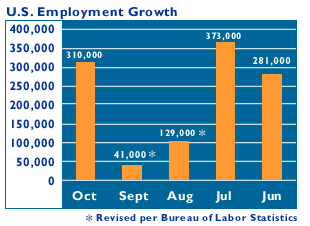|
Are we out of workers?
|
 |
December 2, 1999: 2:46 p.m. ET
November jobs report expected to show tight labor market, higher wages
By Staff Writer M. Corey Goldman
|
NEW YORK (CNNfn) - If Wall Street’s experts are right, Friday’s employment report will confirm what analysts, investors and Federal Reserve policy makers have been fretting about in recent months -- the lack of available workers in the U.S. economy.
According to economists polled by Reuters, some 226,000 new jobs were added to the economy last month, down from the 310,000 positions created a month earlier. Average hourly earnings -- a measure of wage increases -- are expected to have risen 0.3 percent after gaining 0.1 percent in October, according to forecasts. The jobless rate is expected to remain at 4.1 percent, a 29-year low.
On the surface, those numbers could be considered positive for financial markets. They’d suggest fewer new jobs are being created, lowering the probability of another interest rate rise by the Fed. Wages, which can potentially spur inflation as workers spend their growing income, could prove to be tame and the jobless rate may not move.
But underneath, those same numbers could point to what economists, investors and Fed officials have been concerned about for some time: a shrinking pool of workers available to produce the goods and services U.S. consumers continue to demand. And fewer positions means employers could be paying their workers higher wages, leading to inflation.
Buried treasure?
"The traditional interpretation would be that hiring is slowing ahead of a slowing economy,” said Steven Wood, a senior economist with Banc of America Securities in San Francisco. "While that may be true in interest-rate sensitive sectors like housing, hiring may also be constrained by the dwindling number of available workers.”
The Fed last month lifted short-term interest rates by a quarter point -- the third increase this year -- in an effort to slow the economy and keep inflation under wraps. It lifted its trend-setting Fed funds rate to 5.5 percent from 5.25 percent.

At that time, the Fed also said it was switching its bias toward raising rates again to "neutral” from "tightening.” But Fed officials took the somewhat unusual step of explaining what could affect their decision to raise rates again in the future: the growing shortage of American workers.
"...the pool of available workers willing to take jobs has been drawn down further in recent months, a trend that must eventually be contained if inflationary imbalances are to remain in check and economic expansion continue," the Fed said.
Help wanted
That would suggest to financial markets that the Fed would be inclined to lift interest rates again in the new year, said Stephen Slifer, chief economist with Morgan Stanley Dean Witter.
"There is definitely shrinkage in the pool of available workers, and that could at some point lead to higher wages," Slifer said. "If the Fed is looking at that, they could decide to move."

Fed officials next meet Dec. 21 -- four days before Christmas and 10 days before the millennium. Because of the meeting’s proximity to the new year, very few analysts expect the Fed will raise rates again at that time. But that’s not to say the Fed won’t raise rates at its Feb. 2, 2000 meeting.
"It is going to be fascinating to see the market’s reaction to the numbers,” said Rick MacDonald, a senior markets analyst with Standard & Poor’s MMS in San Francisco. "We may not see any surprises in the more-studied numbers, but underneath we could see evidence of a shrinking labor pool.”
Productivity
Of course, a growing number of economists and analysts are convinced that the reason so many people can have jobs without wages rising is because of rising productivity.
Traditional economic models say strong growth and record employment -- features of the economy for several years now -- should have led to a pickup in inflation, and eventually, a recession.
But that has yet to happen -- something a growing number of economists attribute to more worker output per hour as well as stiff global competition. A big contributor has been technology -- including the Internet -- that allows people to work more efficiently and allows companies to reduce costs and keep a lid on prices to compete.
"Productivity has been one of the main driving forces behind the strong employment numbers,” said Ian Shepherdson, chief U.S. economist with High Frequency Economics. "Technology has allowed people to work more efficiently and allowed companies to keep wages under wraps.”
Still, "we are watching carefully for signs that the labor pool is draining,” he said. "Once that happens there will be little choice but for employers to start paying workers more.” 
|
|
|
|
|
 |

|

